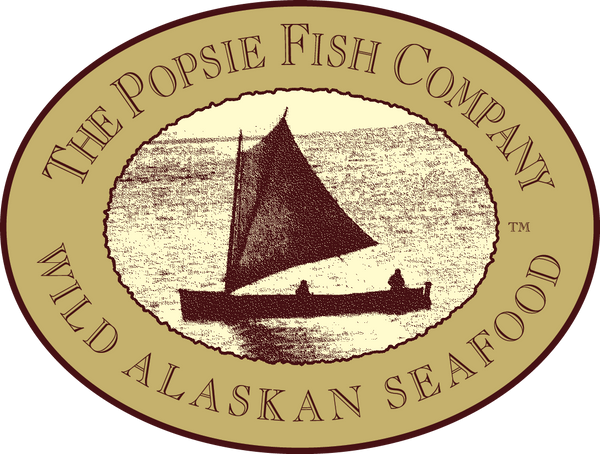
Sockeye Salmon: A Jewel of the Pacific
Wild caught Sockeye salmon laying on crushed ice.
In the crisp, cold waters of the Pacific Northwest, an Iconic species reigns supreme: the Sockeye salmon. Known for its vibrant red flesh and unparalleled journey, the Sockeye salmon is a testament to resilience and natural beauty. But what's the story of this remarkable fish?
Why “Sockeye”?
The name “Sockeye” is believed to have originated from a misinterpretation of words from the indigenous people of British Columbia. The Salish term “suk-kegh” or “suk-kegh-sim” referred to the fish, which settlers mistook as “Sockeye.” Nonetheless, the name stuck, becoming synonymous with this species of salmon (4).
Origins and Habitat
Sockeye salmon, scientifically known as Oncorhynchus nerka, are native to the North Pacific Ocean, the largest populations being in the rivers that flow into Alaska’s Bristol Bay and the Fraser River system in Canada. These fish prefer cool, deep waters and are commonly associated with lakes and rivers along their migratory routes (4).
One of the most awe-inspiring aspects of the Sockeye salmon is its grand journey for spawning. In June and July, after spending several years at sea, salmon return to their freshwater birthplaces to reproduce. As they make their way, their appearance changes and they develop a beautiful red color on their body and a stunning greenish color on their heads. Mature males develop hooked jaws with many tiny teeth and humped backs. Most salmon even stop eating altogether, using the energy that they have gathered from the ocean to make it all the way up river. Their determination is unmatched as they swim against strong currents, leap over waterfalls, and overcome numerous obstacles to reach their spawning grounds. This arduous journey often spans hundreds of miles (3).
Female salmon dig with their tails and lay 2,000 to 5,000 eggs over a few days' time. After spawning, males and females both die within a few weeks. Eggs hatch in the winter, and in the spring they emerge from the safety of gravel and remain in the freshwater as juveniles for 1-3 years. Soon, they will make their way to the ocean for 1-3 more years where they will reach adulthood, until it's time for the cycle to begin again (4).

The Popsie Fish Company fisher Gwen Mistretta pictured with a wild caught Sockeye salmon in Egegik, AK.
Fishing Season and Conservation Efforts
The fishing season for Sockeye salmon varies depending on location, but typically occurs during the summer months when they return to their freshwater spawning grounds. However, strict regulations are in place to ensure sustainable fishing practices and protect the delicate balance of ecosystems. Conservation efforts play a crucial role in maintaining healthy populations of Sockeye salmon, as they are not only vital to the environment but also to the communities that rely on them for sustenance and cultural practices (3).
In Alaska's commercial salmon fishing industry, escapement refers to the number of fish that successfully migrate past fishing gear and reach their spawning grounds. It's a crucial metric for sustainable management, as it ensures enough fish return to breed and maintain healthy populations. Fishery managers set escapement goals based on conservation objectives and scientific data, regulating fishing quotas accordingly to ensure an adequate number of salmon complete their lifecycle. Achieving optimal escapement levels is vital for preserving ecosystem balance, sustaining livelihoods, and safeguarding the future of Alaska's iconic salmon fisheries (1).
Diet and Role in Ecosystems
Sockeye salmon are primarily carnivorous, feeding on a diet of plankton, insects, and small fish while in freshwater and transitioning to a diet of small fish, squid, and crustaceans when they migrate to the ocean. Their feeding habits play a vital role in nutrient cycling within their ecosystem, influencing the health of both freshwater and marine environments (4).
Sockeye salmon are a keystone species; a species that plays an essential role in how the ecosystem that they are surrounded by functions. If a keystone is no longer there, the state of the environment, its biodiversity, and the order in which it functions would change entirely (3).
One example of the Sockeye salmon’s role in an ecosystem is providing sustenance to their predators. Unlike some other species, Sockeye have two different categories of predators to survive. Sockeye salmon have ocean predators, and predators along the riverbanks. The most common ocean predators to Sockeye salmon are sharks, seals, and other marine animals. While on their river journey, their common predators are bears, eagles and sometimes even wolves (3).
Another example of the Sockeye salmon’s key part in an ecosystem, is their death. As we spoke about earlier, Sockeye make the hard journey upstream to spawn, and shortly after, they expire. The decomposition of their bodies feed and support the ecosystem and life cycles of other species around them. Even in death, Sockeye are extremely important.
In conclusion, the Sockeye salmon stands as the symbol of strength, perseverance, and natural wonder. Its life cycle, from freshwater birth to oceanic journey and back again, is a testament to the interconnectedness of ecosystems and the importance of conservation efforts. As we continue to admire and appreciate the beauty of the Sockeye salmon, let us also strive to protect and preserve its habitat for generations to come.
1 Carroll, A. (2005, February). What are Escapement Goals?. Alaska Department of Fish and Game. https://www.adfg.alaska.gov/index.cfm?adfg=wildlifenews.view_article&articles_id=123#:~:text=Escapement%20is%20the%20number,sustained%20yield%20(human%20use).
2 Denchak, Melissa. “Keystone Species 101.” Be a Force for the Future, 9 Sept. 2019, www.nrdc.org/stories/keystone-species-101#what-is.
3 Fisheries, NOAA. “Sustainable Seafood: Understanding Sustainable Seafood: NOAA Fisheries.” Understanding Sustainable Seafood | NOAA Fisheries, www.fisheries.noaa.gov/topic/sustainable-seafood/understanding-sustainable-seafood. Accessed 26 Mar. 2024.
4 “Sockeye Salmon.” Alaska Department of Fish and Game, www.adfg.alaska.gov/index.cfm?adfg=sockeyesalmon.printerfriendly#:~:text=On%20the%20west%20coast%20of,Fraser%20River%20system%20in%20Canada. Accessed 27 Mar. 2024.